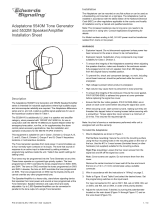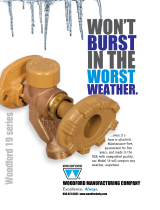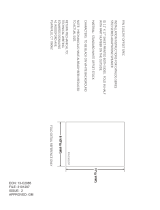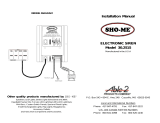Page is loading ...

© 2010 UTC Fire & Security. All rights reserved. 1 / 7 P/N 3100006 • REV 4 • ISS 09AUG10
5530M and 5530MHV Adaptatone Installation
Sheet
Description
Edwards Adaptatone is a heavy-duty, tone-selectable, stand
alone, indoor/outdoor audible signaling device intended for
industrial applications where high audible output and
microcomputer reliability are required. Additionally, the
Adaptatone Millennium series are UL and cUL Listed as
Audible Signal Appliances for use in the following hazardous
locations.
The Adaptatone operates from local power and sounds a
high decibel signal determined by the setting of miniature
programming switches inside the unit. The Adaptatone may
be programmed for any of the 55 tones listed in Table 6.
Speaker direction and the output level are easily adjustable.
Installation
The Adaptatone may be mounted to any flat surface or may
be used as a freestanding unit mounted to a rigid pipe. The
Adaptatone must be installed in accordance with the latest
edition of the National Electrical Code or other regulations
applicable to the country and locality of installation and by a
trained and qualified electrician.
For catalog numbers ending in "AQ", 24 VAC power must be
transformer isolated from mains or line power.
WARNING: To prevent fire, shock and component damage,
NO work, including circuit board removal, should be
performed while the circuit is energized.
NOTE: Any kind of service or maintenance performed
while unit is energized will void the warranty.
1. Mount Adaptatone as shown in Figure 2.
a. Flat Surface Mounting. Secure unit to mounting
surface using the (4) mounting holes in the
mounting plate on the rear of the box. Use the #10
x 3" (76 mm) wood screws (furnished loose) or
other hardware (not supplied) suitable for the
mounting surface.
b. Rigid Pipe Mounting. Loosen the (4) cover
screws from the signal box and lift off signal box
cover.
NOTE: Cover screws are captive. Do not remove from
cover.
Remove the center knockout in lower wall of box
and mount box to a 1/2” (12.7 mm) conduit pipe
using suitable connector.
2. Wire in accordance with the instructions in “Wiring.”
3. Refer to Figure 14 and Table 6 and select desired
tones. Set miniature programming switches on the input
board.
WARNING: HIGH VOLTAGE is present when product is
energized. High volume may cause harm to personnel in
close proximity.
4. Adjust volume level, if desired, by turning potentiometer
located on the main board (Figure 14).
WARNINGS: To ensure integrity of the enclosure: Ensure
the cover gasket, part number P-007549-0069, is adhered
into groove at cover perimeter before replacing the signal
box cover.
Ensure that the (4) collar gaskets, part number P-041930-
0362, are in place on each cover screw before securing the
signal box cover.
When securing cover, start screws by hand, making sure
they are threaded into tapped holes in housing bosses
before securing with a screwdriver. Torque signal box cover
screws to a minimum of 20 in-lbs. This ensures the required
tight fit.
5. Tightly secure the signal box cover using (4) retained
cover screws.

2 / 7 P/N 3100006 • REV 4 • ISS 09AUG10
6. Torque signal box cover screws to a minimum of 20 in-
lbs.
WARNING: To ensure integrity of the Adaptatone assembly
when adjusting the speaker direction, make sure threads in
the enclosure remain fully engaged and do not turn speaker
more than 360 degrees from the original factory installed
position.
7. To adjust speaker direction, loosen large star nut
(Figure 1) and turn speaker to the approximate desired
position.
8. Regardless of speaker direction adjustment, it is
important that the star nut be tightened wrench tight to
ensure the speaker position is maintained securely.
9. Verify operability.
Wiring
1. Install wires through a knockout hole in the bottom of
the box from a raceway that is, with its connections to
the 1/2" (12.7 mm) conduit knockout hole, approved for
the same degree of protection and enclosure type
needed by the application. Use the provided plastic tie-
wrap, on the barrier to the electronics, to separate
incoming power leads from signal and tone initiating
leads, per NEC (Figure 4).
WARNING: To prevent fire and shock, wire the Adaptatone
only as described in this installation instruction.
2. Wire as follows referring to Figure 4.
a. Connect green and yellow-striped earth-ground
wires to earth-ground.
b. Select the appropriate method for wiring to the input
board from Figure 5 through Figure 13.
c. Connect incoming power to wire leads using a butt
splice or other method listed, certified, or otherwise
approved by local authorities. Leads are both black
for -AQ and -N5 models and are black and white for
-Y6 models.
d. Optional. Connect external 24V DC battery (not
supplied) in series with separate diode assembly
part 2600010 (supplied) to TB1 terminals 3 and 4
on the main board as shown in Figure 2 and
Figure 3 and marked on the diode assembly.
NOTE: Terminal Block TB1 can be unplugged from the
main board to complete wiring as shown in Figure 2.
Maintenance and testing
WARNING: To prevent fire, shock and component damage,
NO work including circuit board removal, should be
performed while the circuit is energized.
NOTE: Any kind of service or maintenance performed
while unit is energized will void the warranty.
Examine the unit semi-annually for accumulation of dirt.
Clean if necessary.
The Adaptatone should be tested annually or as required by
the authority having jurisdiction to ensure continuous
service.
Figure 1: Adaptatone mounting
Figure 2: Terminal block TB1
Figure 3: Wiring to terminal block TB1 input circuit

P/N 3100006 • REV 4 • ISS 09AUG10 3 / 7
Figure 4: Wiring the Adaptatone
Figure 5: Wiring a dry relay contact to 24 V input board,
method 1 (refer to Applications Engineering for compatibility
with earlier versions of Adaptatone)
Figure 6: Wiring a dry relay contact to 24V input board, method
2
Figure 7: 24 VDC strapped input, 24 V input board
Figure 8: Wiring to 24 V input board with an open collector
transistor
Figure 9: Connecting 24 V input board in parallel with
Adaptatone “B” (limit of 5 “M” models)
Figure 10: Connecting 24 V input board to a PLC. See Table 5

4 / 7 P/N 3100006 • REV 4 • ISS 09AUG10
Figure 11: 120 VAC strapped input, 120 V input board
Figure 12: 120 VAC to 240 VAC or 120 VDC – 250 VDC, 120 V
input board
Figure 13: Connecting from a PLC to 120 V input board. See
Table 5
Figure 14: PC board locations
Specifications
Voltage Refer to Table 2 and Table 3
Current Refer to Table 2 and Table 3
Dimensions Refer to Table 4 on page 5
Weight 9 lb (4.1 kg)
Hazardous locations
Ambient temp.
-31 to 104°F (-35 to +40°C)
Non-hazardous
locations
Variable ambient
temp
-40 to 151°F (-40 to +66°C)
Table 1: Operating temperature codes
Catalog number
Class I, Div. 2
Groups A, B, C, D
Class II, Div. 2,
Groups F, G
Class III, Div. 1 and 2
5530M-24AQ
5530M-24N5
5530MHV-24AQ
5530M-120N5
135°C (T4) 100°C (T5)
5530M-24Y6
5530MHV-24Y6
5530M-120Y6
5530MHV-120Y6
180°C (T3A) 100°C (T5)
Table 2: Input board
Catalog number Voltage Current
5530M-24AQ
5530M-24N5
5530MHV-24AQ
5530MHV-24Y6
24 VDC 6 mA
5530M-120N5
5530M-120Y6
5530MHV-120Y6
120 VAC 50/60 Hz 13 mA
Table 3: Main power
Catalog number Voltage Standby
current
Tone on
current
5530M-24AQ
24 VDC
24 VAC 50/60 Hz
0.10 A
0.10 A
0.74 A
1.3 A
5530M-24N5 120 VAC 50/60 Hz 0.10 A 0.36 A

P/N 3100006 • REV 4 • ISS 09AUG10 5 / 7
Catalog number Voltage Standby
current
Tone on
current
5530M-120N5
120 VAC 50/60 Hz 0.10 A 0.38 A
5530M-24Y6
125 VDC
250 VDC
120 VAC 50/60 Hz
240 VAC 50/60 Hz
0.10 A
0.02 A
0.10 A
0.10 A
0.20 A
0.10 A
0.32 A
0.20 A
5530M-120Y6
125 VDC
250 VDC
120 VAC 50/60 Hz
240 VAC 50/60 Hz
0.10 A
0.02 A
0.10 A
0.10 A
0.20 A
0.10 A
0.31 A
0.20 A
5530MHV-24AQ
24 VDC
24 VAC 50/60 Hz
0.10 A
0.10 A
1.5 A
2.3 A
5530MHV-24Y6
125 VDC
250 VDC
120 VAC 50/60 Hz
240 VAC 50/60 Hz
0.10 A
0.02 A
0.10 A
0.10 A
0.39 A
0.19 A
0.56 A
0.34 A
5530MHV-120Y6
125 VDC
250 VDC
120 VAC 50/60 Hz
240 VAC 50/60 Hz
0.10 A
0.02 A
0.10 A
0.10 A
0.40 A
0.20 A
0.62 A
0.37 A
Table 4: Dimensions
5530M 5530MHV
A 8 7/8” (225 mm) 11 1/2” (292 mm)
B 8 1/4” (210 mm) 9 3/4” (248 mm)
C 13” (330 mm) 14 1/4” (362 mm)
Table 5: PLC compatibility: PLC output to meet following product input parameters. Refer to Figure 10 and Figure 13.
Catalog number Operating voltage Max. off state leakage
current
Continuous on current Surge (inrush/duration)
5530M-24AQ 24 VDC only 2 mA 740 mA 8 A / 4 mS
5530M-24N5 120 VAC 50/60 Hz 2 mA 360 mA 2.82 A / 4 mS
5530MHV-24AQ 24 VDC only 2 mA 1500 mA 8 A / 4 mS
5530M-120N5 120 VAC 50/60 Hz 5 mA 380 mA 2.82 A / 4 mS
Input board circuit 24 VDC 2 mA 6 mA --
Table 6: Tone programming
Tone SW 4-6 SW 4-5 SW 4-4 SW 4-3 SW 4-2 SW4-1 Description Hex
No Tone OFF OFF OFF OFF OFF OFF 00
Ding-Dong OFF OFF OFF OFF OFF ON Percussive pairs of 700 and 570 Hz tones, each
damped to 0
01
Warble OFF OFF OFF OFF ON OFF 575 and 770 Hz alternately, 87 ms each 02
Siren OFF OFF OFF OFF ON ON 600 – 1250 Hz up and down sweep in 8 s and repeat 03
Stutter OFF OFF OFF ON OFF OFF Percussive 470 Hz, 83 ms on, 109 ms off 04
Slow Whoop OFF OFF OFF ON OFF ON 600 – 1250 Hz upward sweep in 4 s and repeat 05
Beep OFF OFF OFF ON ON OFF 470 Hz, 0.55 s on, 0.55 s off 06
Chime 1 OFF OFF OFF ON ON ON 700 Hz percussive repeat at 1 Hz 07
Fast Whoop OFF OFF ON OFF OFF OFF 600 – 1250 Hz upward in 1 s and repeat 08
Hi/Lo OFF OFF ON OFF OFF ON 780 to 600 Hz alternately, 0.52 s each 09
Rapid Siren OFF OFF ON OFF ON OFF 600 – 1250 Hz up and down sweep in 0.25 s and repeat 0A
Yeow OFF OFF ON OFF ON ON 1250 – 600 Hz downward sweep in 1.6 s and repeat 0B
Horn OFF OFF ON ON OFF OFF 470 Hz continuous 0C
Air Horn OFF OFF ON ON OFF ON 370 Hz continuous 0D
Dual Tone OFF OFF ON ON ON OFF 470 – 500 Hz, 0.4 to 0.5 s cycle 0E
Chime 2 OFF OFF ON ON ON ON 575 Hz percussive repeat at 1 Hz 0F
Westminster OFF ON OFF OFF OFF OFF Two measures, 411 Hz, 520 Hz, 407 Hz, 312 Hz 10
Three Blind Mice OFF ON OFF OFF OFF ON Four measures, 787 Hz, 714 Hz, 625 Hz, 952 Hz, 333
Hz
11
Phasor OFF ON OFF OFF ON OFF 416 – 625 Hz up and down sweep in 13 ms and repeat 12
Telephone OFF ON OFF OFF ON ON 570 and 770 Hz alternately, 50 ms each for 1.2s, 1.5s
delay and repeat
13
Staircase OFF ON OFF ON OFF OFF 440 – 2000 Hz up and down steps, 750 ms delay and
repeat
14

6 / 7 P/N 3100006 • REV 4 • ISS 09AUG10
Tone SW 4-6 SW 4-5 SW 4-4 SW 4-3 SW 4-2 SW4-1 Description Hex
3 Tone Alert OFF ON OFF ON OFF ON 463 Hz, 641 Hz, and 896 Hz, 200 ms each, 1 s delay
and repeat
15
RESERVED OFF ON OFF ON ON OFF RESERVED 16
RESERVED OFF ON OFF ON ON ON RESERVED 17
RESERVED OFF ON ON OFF OFF OFF RESERVED 18
RESERVED OFF ON ON OFF OFF ON RESERVED 19
RESERVED OFF ON ON OFF ON OFF RESERVED 1A
NFPA Whoop OFF ON ON OFF ON ON Three 422 – 775 Hz upward sweeps, 850 ms each, 1 s
delay and repeat
1B
3 Pulse Horn* OFF ON ON ON OFF OFF 470 Hz, 3 0.5 s pulses separated by 0.5 s followed by
1.5 s delay and repeat
1C
3 Pulse Air Horn* OFF ON ON ON OFF ON 370 Hz, 3 0.5 s pulses separated by 0.5 s followed by
1.5 s delay and repeat
1D
3 Pulse Dual
Tone*
OFF ON ON ON ON OFF 450 – 500 Hz, 0.4 to 0.5 s cycle, 3 0.5s pulses
separated by 0.5 s followed by 1.5 s delay and repeat
1E
3 Pulse Chime 2* OFF ON ON ON ON ON 575 Hz, 3 0.5 s pulses separated by 0.5 s followed by
1.5 s delay and repeat
1F
European Police ON OFF OFF OFF OFF OFF 969 Hz and 800 Hz alternately 0.250 s each 20
European Fire ON OFF OFF OFF OFF ON 982 Hz and 864 Hz downward sweep in 0.134 s 21
European Slow
Whoop
ON OFF OFF OFF ON OFF 658 – 1312 Hz upward sweep in 3 s followed by 0.5 s
delay and repeat
22
European General ON OFF OFF OFF ON ON 1087 Hz for 0.5 s followed by 0.5 s delay and repeat 23
European Toxic ON OFF OFF ON OFF OFF 982 Hz continuous 24
European Police 2 ON OFF OFF ON OFF ON 554 Hz and 440 Hz alternately, 0.8 s each 25
European Stutter ON OFF OFF ON ON OFF 3876 Hz for 0.146 s followed by 0.102 s delay and
repeat
26
European Sweep ON OFF OFF ON ON ON 1315 Hz – 413 Hz downward sweep in 1.17 s and
repeat
27
Telephone 2 ON OFF ON OFF OFF OFF Alternate tones at 567 Hz and 326 Hz 28
Buzzer ON OFF ON OFF OFF ON 1315 Hz and 746 Hz alternating for 0.003 s each 29
Genesis Horn Cont ON OFF ON OFF ON OFF Continuous Genesis horn 2A
Genesis Horn
Temp
ON OFF ON OFF ON ON Temporal Genesis horn 2B
Warning 1 ON OFF ON ON OFF OFF 1207 Hz and 493 Hz, alternately 0.002 s each 2C
Warning 2 ON OFF ON ON OFF ON 2336 Hz and 493 Hz, alternately 0.005 s each 2D
Warning 2 Beep ON OFF ON ON ON OFF 0.500 s of 2336 Hz and 493 Hz each alternating for
0.005 s followed by 1 s delay
2E
Caution ON OFF ON ON ON ON 453 Hz for 0.040 s, 235 Hz for 0.020 s, 235 Hz for 0.160
s, 260 Hz for 0.050 s, 260 Hz for 0.1009 s, 235 Hz for
0.050 s
2F
Multi-tone ON ON OFF OFF OFF OFF 376, 357, 352, 382, 355, 375, 384, 375 and 364 Hz
alternately on for 0.050 s
30
Attention ON ON OFF OFF OFF ON 2232, 4545, 3704, 2777, 4347, 3704, 2500 Hz
alternately on for 0.003 s
31
High Freq. Steady
Alert
ON ON OFF OFF ON OFF 2500 Hz continuous 32
High Freq. Fast
Siren
ON ON OFF OFF ON ON 2500 – 3048 Hz up and down sweep in 0.130 s 33
High Freq. Slow
Siren
ON ON OFF ON OFF OFF 2500 – 3048 Hz up and down sweep in 0.500 s 34
DIN PFEER ON ON OFF ON OFF ON Ramp downward from 1336 Hz to 522 Hz in 1.2 s and
repeat
35
NF S 32 001 ON ON OFF ON ON OFF 584 Hz for 0.100 s and 461 Hz for 0.400 s 36
Ode to Joy ON ON OFF ON ON ON 6.45 s of melody followed by 1 s delay and repeat 37
Twinkle Little Star ON ON ON OFF OFF OFF 13.2 s of melody followed by 1 s delay and repeat 38
Dueling Banjos ON ON ON OFF OFF ON 10.84 s of melody followed by 1 s delay and repeat 39
La Cucaracha ON ON ON OFF ON OFF 7.10 s of melody followed by 1 s delay and repeat 3A
Yellow Rose of TX ON ON ON OFF ON ON 19.34 s of melody followed by 1 s delay and repeat 3B
*3 Pulse Tones are for Evacuation Use Only

P/N 3100006 • REV 4 • ISS 09AUG10 7 / 7
CAUTION: The use of evacuation signals on this product, that is not specifically listed for fire alarm use, is subject to the approval
of the authority having jurisdiction.
Regulatory information
Edwards Signaling Edwards, A Division of UTC Fire & Security
Americas Corporation, Inc.
8985 Town Center Parkway, Bradenton, FL
34202, USA
UL and cUL Rated Audible Signal Appliance
Contact information
For contact information, see www.edwardssignaling.com.

P/N 3100006 OFFSET
INSTALLATION INSTRUCTIONS FOR CATALOG
SERIES 5530M ADAPTATONE
(2) 11” X 17” SHEET PRINTED BOTH SIDES. COLLATE AND FOLD IN HALF PER
FOLD DETAIL WITH PART NUMBER ON THE OUTSIDE. SADDLE STITCH IN TWO
PLACES.
MATERIAL: STANDARD WHITE OFFSET STOCK
CHARACTERS TO BE BLACK ON WHITE BACKGROUND
NOTE: MECHANICALS HAVE ALREADY BEEN REDUCED TO ACTUAL SIZE.
RETURN MECHANICALS TO:
TECHNICAL WRITING
EDWARDS SIGNALING
41 WOODFORD AVENUE
PLAINVILLE, CT 06062
ECN: 10-C1937
ISSUE: 04
FILE: 3100006
APPROVED BY: GM
/




